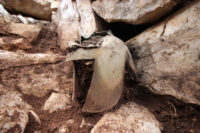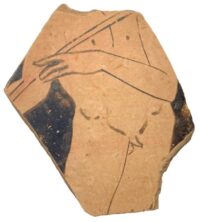 Archaeologists have unearthed an extremely rare Greek-Illyrian helmet in Zakotarac, Croatia. The bronze open-faced helmet was discovered in a cave tomb from the 4th century that was richly furnished with grave goods. The presence of the helmet suggests the tomb belonged to an elite warrior.
Archaeologists have unearthed an extremely rare Greek-Illyrian helmet in Zakotarac, Croatia. The bronze open-faced helmet was discovered in a cave tomb from the 4th century that was richly furnished with grave goods. The presence of the helmet suggests the tomb belonged to an elite warrior.
“In the grave we also found fragments of other iron weapons such as spears and knives. However, in addition to the warrior, at least two more persons were buried, one of whom was a woman, as indicated by the fragments of a bronze bracelet. The helmet itself is the standard type we call the Greek-Illyrian helmet. Such a helmet has several developmental stages, and this variant from the fourth century BC was used in both Greek and Illyrian areas. It is bronze, has a solid head protection and a characteristic rectangular cut for the face. To date, only about 40 have been found in Europe,” says project coordinator Dr. Hrvoje Potrebica from the Department of Archaeology of Zagredb University.
 Fifteen bronze and silver fibulae, a dozen needles, spiral bronze jewelry, tweezers and hundreds of glass paste and amber beads were also found in the cave tomb, furnishings typical of female burials.
Fifteen bronze and silver fibulae, a dozen needles, spiral bronze jewelry, tweezers and hundreds of glass paste and amber beads were also found in the cave tomb, furnishings typical of female burials.
The landscape around the village is dotted with mounds which were part of a prehistoric settlement. Many of them have been damaged and looted over the centuries, and the tomb where the helmet was found was discovered during work on one of the looted mounds. The tomb, a rectangle about 10 by 6.5 feet in dimension, was cut out of the bedrock. Skeletal remains were found, but they are in such bad condition that archaeologists can only say that the body appears to have been laid in a west-east orientation.
 The site has only recently been formally excavated. Archaeologists were invited by local historians to explore Peljesac in 2019. It is near an important Illyrian cave sanctuary where offerings were made to fertility deities between the 4th and 1st centuries B.C. The remains of more than 30 different pottery vessels, most of them Greek made either in the Attic peninsula or one of the southern Italian colonies, have been found in the sanctuary, deposited around a stalagmite that is believed to have been a phallic symbol. These were the most desirable and most expensive vessels available in the Mediterranean at that time. There is no direct evidence that they were traded to the area; it’s possible they were the spoils of piracy.
The site has only recently been formally excavated. Archaeologists were invited by local historians to explore Peljesac in 2019. It is near an important Illyrian cave sanctuary where offerings were made to fertility deities between the 4th and 1st centuries B.C. The remains of more than 30 different pottery vessels, most of them Greek made either in the Attic peninsula or one of the southern Italian colonies, have been found in the sanctuary, deposited around a stalagmite that is believed to have been a phallic symbol. These were the most desirable and most expensive vessels available in the Mediterranean at that time. There is no direct evidence that they were traded to the area; it’s possible they were the spoils of piracy.
 Excavations conducted between June and September of this year explored several of the prehistoric mounds surrounding the village. Two graves, one dating to the 10th century, B.C. the other to the 7th century B.C., were unearthed, underscoring the vast temporal scope of the finds in this area.
Excavations conducted between June and September of this year explored several of the prehistoric mounds surrounding the village. Two graves, one dating to the 10th century, B.C. the other to the 7th century B.C., were unearthed, underscoring the vast temporal scope of the finds in this area.
“The enormous potential of this site will encourage a more systematic approach to overall research. We hope that next year we will have the opportunity to continue our research to give the findings a broader context and to better understand, adequately protect and, in cooperation with the local community, present these unique landscapes that, combined with exceptional finds on Korcula, open a completely new picture of the importance of the southern Adriatic in the historical dynamics of this part of Europe,” said Potrebica.
Even for an Illyrian site this looks remarkably …balkanized :confused: